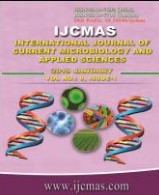


 National Academy of Agricultural Sciences (NAAS)
National Academy of Agricultural Sciences (NAAS)

|
PRINT ISSN : 2319-7692
Online ISSN : 2319-7706 Issues : 12 per year Publisher : Excellent Publishers Email : editorijcmas@gmail.com / submit@ijcmas.com Editor-in-chief: Dr.M.Prakash Index Copernicus ICV 2018: 95.39 NAAS RATING 2020: 5.38 |
An experiment was conducted to study the nematicidal toxicity of native antagonists against Meloidogyne incognita. For this the native antagonists viz., Pseudomonas fluorescens, Bacillus megaterium, Azotobacter sp., Rhizobium sp., Purpureocillium lilacinum and Pochonia chlamydosporia were screened against Meloidogyne incognita under in-vitro conditions. For this, four different concentrations of culture filtrates viz., 25, 50, 75 100 percent were tested against M. incognita through egg hatch inhibition and second-stage juvenile’s mortality at 24, 48, 72 and 96 hrs of exposure time for each antagonist. The entire antagonists were also found to be effective in causing mortality of J2 with varying degrees at different concentrations of culture filtrates and at different exposure time. The relationship among the antagonists, concentration and time showed that all the tested antagonists were able to cause significant mortality of M. incognita J2with increase in the concentrations of filtrates and time of exposure. The result of in-vitro test reveals that all the tested antagonists showed varied nature of egg hatch inhibition and juvenile mortality of M. incognita. However, among the tested antagonists P. fluorescens was found to be most effective in causing the highest egg hatch inhibition and J2 mortality of M. incognita in 25, 50, 75 and 100 per cent concentration of culture filtrates at 24, 48, 72 and 96 hrs of exposure time. Further, probit analysis showed that culture filtrate of P. fluorescens exhibit either low LC50 values or less LT50 values against J2 of M. incognita in 25, 50, 75 and 100 percent concentration of culture filtrates at 24, 48, 72 and 96 hrs of exposure time as compared to the others antagonists and found to be best native antagonists against M. incognita.
 |
 |
 |
 |
 |